Related Research Articles
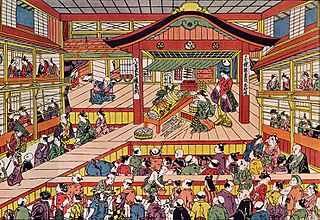
Ukiyo-e is a genre of Japanese art that flourished from the 17th through 19th centuries. Its artists produced woodblock prints and paintings of such subjects as female beauties; kabuki actors and sumo wrestlers; scenes from history and folk tales; travel scenes and landscapes; flora and fauna; and erotica. The term ukiyo-e translates as 'picture[s] of the floating world'.

Utagawa Kunisada, also known as Utagawa Toyokuni III, was a Japanese ukiyo-e artist. He is considered the most popular, prolific and commercially successful designer of ukiyo-e woodblock prints in 19th-century Japan. In his own time, his reputation far exceeded that of his contemporaries, Hokusai, Hiroshige and Kuniyoshi.

The history of books became an acknowledged academic discipline in the 1980s. Contributions to the field have come from textual scholarship, codicology, bibliography, philology, palaeography, art history, social history and cultural history. Its key purpose is to demonstrate that the book as an object, not just the text contained within it, is a conduit of interaction between readers and words. Analysis of each component part of the book reveals its purpose, where and how it was kept, who read it, ideological and religious beliefs of the period, and whether readers interacted with the text within. Even a lack of evidence of this nature leaves valuable clues about the nature of that particular book.

Woodblock printing or block printing is a technique for printing text, images or patterns used widely throughout East Asia and originating in China in antiquity as a method of printing on textiles and later on paper. Each page or image is created by carving a wooden block to leave only some areas and lines at the original level; it is these that are inked and show in the print, in a relief printing process. Carving the blocks is skilled and laborious work, but a large number of impressions can then be printed.
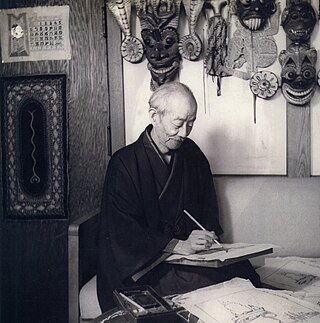
Hiroshi Yoshida was a 20th-century Japanese painter and woodblock printmaker. Along with Hasui Kawase, he is regarded as one of the greatest artists of the shin-hanga style, and is noted especially for his landscape prints. Yoshida made numerous trips around the world, with the aim of getting to know different artistic expressions and making works of different landscapes. He traveled widely, and was particularly known for his images of non-Japanese subjects done in traditional Japanese woodblock style, including the Taj Mahal, the Swiss Alps, the Grand Canyon, and other National Parks in the United States.
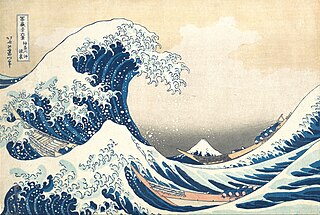
Woodblock printing in Japan is a technique best known for its use in the ukiyo-e artistic genre of single sheets, but it was also used for printing books in the same period. Invented in China during the Tang dynasty, woodblock printing was widely adopted in Japan during the Edo period (1603–1868). It is similar to woodcut in Western printmaking in some regards, but was widely used for text as well as images. The Japanese mokuhanga technique differs in that it uses water-based inks—as opposed to Western woodcut, which typically uses oil-based inks. The Japanese water-based inks provide a wide range of vivid colors, glazes, and transparency.

The Great Wave off Kanagawa is a woodblock print by Japanese ukiyo-e artist Hokusai, created in late 1831 during the Edo period of Japanese history. The print depicts three boats moving through a storm-tossed sea, with a large, cresting wave forming a spiral in the centre and Mount Fuji visible in the background.
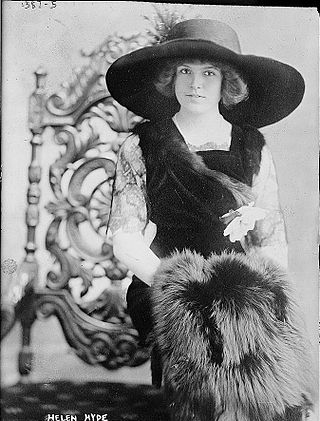
Helen Hyde was an American etcher and engraver. She is best known for her color etching process and woodblock prints reflecting Japanese women and children characterizations.

Elizabeth Keith was a Scottish artist and writer. She was a print-maker and watercolorist whose works were significantly influenced by her travels to Japan, China, Korea and the Philippines.

William Seltzer Rice was an American woodblock print artist, art educator and author, associated with the Arts and Crafts movement in Northern California.
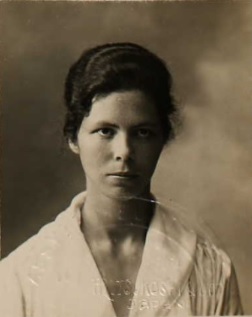
Lilian May Miller was an American painter, woodblock printmaker and poet born in Tokyo, Japan. In the world of art she marked her place with imagery, while she attended presentations in traditional kimonos, and signed her paintings with a monogram.

The visual arts are art forms such as painting, drawing, printmaking, sculpture, ceramics, photography, video, filmmaking, comics, design, crafts, and architecture. Many artistic disciplines, such as performing arts, conceptual art, and textile arts, also involve aspects of the visual arts as well as arts of other types. Also included within the visual arts are the applied arts, such as industrial design, graphic design, fashion design, interior design, and decorative art.
Sarah Brayer is an American artist who works in both Japan and the United States. She is internationally known for her poured washi paperworks, aquatint and woodblock prints. In 2013 Japan's Ministry of Culture awarded Sarah its Bunkacho Chokan Hyosho for dissemination of Japanese culture abroad through her creations in Echizen washi. She currently resides in Kyoto, Japan and New York, U.S.A.
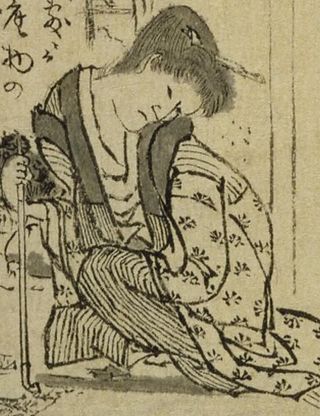
Katsushika Ōi, also known as Ei (栄) or Ei-jo, was a Japanese Ukiyo-e artist of the early 19th century Edo period. She was a daughter of Hokusai from his second wife. Ōi was an accomplished painter who also worked as a production assistant to her father.

Tetsuya Noda is a contemporary artist, printmaker and educator. He is widely considered to be Japan’s most important living print-artist, and one of the most successful contemporary print artists in the world. He is a professor emeritus of the Tokyo University of the Arts. Noda is most well-known for his visual autobiographical works done as a series of woodblock, print, and silkscreened diary entries that capture moments in daily life. His innovative method of printmaking involves photographs scanned through a mimeograph machine and then printed the images over the area previously printed by traditional woodblock print techniques onto the Japanese paper. Although this mixed-media technique is quite prosaic today, Noda was the first artist to initiate this breakthrough. Noda is the nephew of Hideo Noda an oil painter and muralist.
May Gearhart was an American printmaker who was part of an early 20th century circle of Southern California printmakers strongly influenced by the Arts and Crafts movement and Japanese art.

The conservation and restoration of woodblock prints, is the process of caring for and repairing images made from a specific printing process involving using wooden reliefs to stamp or imprint an image onto paper. The process of creating woodblock prints as Asian examples are known, or woodcuts as Western examples are called, has been known for many centuries, and many older prints have experienced aging and deterioration of the paper and colorants used.
Kitaoka Fumio was a Japanese artist. He was trained in oil painting, and later became interested in woodblock printing.
Ansei Uchima was an American artist and teacher primarily known as a sōsaku-hanga woodblock printmaker who employed traditional ukiyo-e Japanese techniques to produce abstract works covering a range of distinct personal styles.
Unsodo is a Japanese publishing company, specializing in art books. The company was founded in 1891 in Kyoto, Japan by Yamada Naosaburō (山田直三郎), and continues operations at its headquarters in Nakagyo-ku, Kyoto. Amongst other products, they produce hand carved and printed woodblock prints.
References
- 1 2 "April Vollmer". Blanton Museum of Art . Archived from the original on 12 May 2023. Retrieved 12 May 2023.
- ↑ "April Vollmer". Women's Studio Workshop . Archived from the original on 15 May 2023. Retrieved 12 May 2023.
- ↑ "April Vollmer". Morgan Conservatory. Archived from the original on 19 June 2023. Retrieved 12 May 2023.
- ↑ "Visual Art - Print Making - April Vollmer". MacDowell . Archived from the original on 14 May 2023. Retrieved 12 May 2023.
- ↑ "April Vollmer Publishes "Japanese Woodblock Printing Workshop"". Virginia Center for the Creative Arts (VCCA) . 20 August 2015. Archived from the original on 14 May 2023. Retrieved 12 May 2023.
- ↑ Vollmer, April (2015). Japanese Woodblock Print Workshop: A Modern Guide to the Ancient Art of Mokuhanga. Berkeley: Watson-Guptill. ISBN 978-0770434816. OCLC 903363548.
- ↑ Vollmer, April (2016). Pests of Public Importance. Book design by Esther K. Smith, hand set and printed by Dikko Faust, with a constructed poem by Georgia Luna Smith Faust. New York: Purgatory Pie Press. OCLC 1028051799.
- ↑ "Pests of Public Importance". National Museum of Women in the Arts Library & Research Center (Library catalog record). Archived from the original on 17 November 2023. Retrieved 12 May 2023.